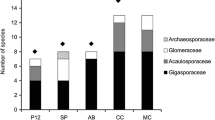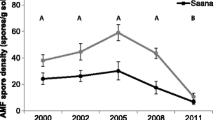Abstract
Spores are important propagules as well as the most reliable species-distinguishing traits of arbuscular mycorrhizal (AM) fungi. During surveys of AM fungal communities, spore enumeration and spore identification are frequently conducted, but generally little attention is given to the age and viability of the spores. In this study, AM fungal spores in the rhizosphere were characterized as live or dead by vital staining and by performing a germination assay. A considerable proportion of the spores in the rhizosphere were dead despite their intact appearance. Furthermore, morphological and molecular analyses of spores to determine species identity revealed that both viable spores and dead spores with contents were identified. The accurate identification of spores at different developmental stages on the basis of morphology requires considerable experience. Our findings suggest that surveys of AM fungal communities based on spore enumeration and morphological and molecular identification are likely to be inaccurate, primarily because of the large proportion of dead spores in the rhizosphere. A viability check is recommended prior to spore molecular identification, and the use of trap cultures would give more reliable morphological identification results. We show that the abundance and activity of AM fungi in the rhizosphere can be determined by calculating the density of viable spores and the density of spores that could germinate. The adoption of these methods should provide a more reliable basis for further AM fungal community analysis.




Similar content being viewed by others
References
Abbott LK, Robson AD (1991) Factors influencing the occurrence of vesicular–arbuscular mycorrhizas. Agric Ecosyst Environ 35:121–150. doi:10.1016/0167-8809(91)90048-3
An ZQ, Guo BZ, Hendrix JW (1998) Viability of soilborne spores of glomalean mycorrhizal fungi. Soil Biol Biochem 30:1133–1136. doi:10.1016/s0038-0717(97)00194-6
Bao SD (2000) Agricultural chemistry analysis of soils. China Agriculture Press, Beijing
Baylis GTS (1969) Host treatment and spore production by Endogone. N Z J Bot 7:173–174. doi:10.1080/0028825X.1969.10429115
Bécard G, Fortin JA (1988) Early events of vesicular–arbuscular mycorrhiza formation on Ri T-DNA transformed roots. New Phytol 108:211–218. doi:10.1111/j.1469-8137.1988.tb03698.x
Brundrett M, Bougher NL, Dell B, Grove T, Malajczuk N (1996) Working with mycorrhizas in forestry and agriculture. Australian Centre for International Agricultural Research, ACIAR monograph 32, Canberra, ACT, Australia
Castillo CG, Rubio R, Rouanet JL, Borie F (2006) Early effects of tillage and crop rotation on arbuscular mycorrhizal fungal propagules in an Ultisol. Biol Fertil Soils 43:83–92. doi:10.1007/s00374-005-0067-0
Druille M, Cabello MN, Omacini M, Golluscio RA (2013) Glyphosate reduces spore viability and root colonization of arbuscular mycorrhizal fungi. Appl Soil Ecol 64:99–103. doi:10.1016/j.apsoil.2012.10.007
Gai JP, Christie P, Feng G, Li XL (2006) Twenty years of research on community composition and species distribution of arbuscular mycorrhizal fungi in China: a review. Mycorrhiza 16:229–239. doi:10.1007/s00572-005-0023-8
Gerdemann JW, Nicolson TH (1963) Spores of mycorrhizal Endogone species extracted from soil by wet sieving and decanting. Trans Br Mycol Soc 46:235–244. doi:10.1016/s0007-1536(63)80079-0
Giovannetti M (2000) Spore germination and pre-symbiotic mycelial growth. In: Kapulnik Y, Douds DD Jr (eds) Arbuscular mycorrhizas: physiology and function. Springer, Netherlands, pp 47–68
Hijri I, Sýkorová Z, Oehl F, Ineichen K, Mäder P, Wiemken A, Redecker D (2006) Communities of arbuscular mycorrhizal fungi in arable soils are not necessarily low in diversity. Mol Ecol 15:2277–2289. doi:10.1111/j.1365-294X.2006.02921.x
Juge C, Samson J, Bastien C, Vierheilig H, Coughlan A, Piche Y (2002) Breaking dormancy in spores of the arbuscular mycorrhizal fungus Glomus intraradices: a critical cold-storage period. Mycorrhiza 12:37–42. doi:10.1007/s00572-001-0151-8
Klironomos J, Hart M (2002) Colonization of roots by arbuscular mycorrhizal fungi using different sources of inoculum. Mycorrhiza 12:181–184. doi:10.1007/s00572-002-0169-6
Lee P-J, Koske RE (1994) Gigaspora gigantea: seasonal abundance and ageing of spores in a sand dune. Mycol Res 98:453–457. doi:10.1016/S0953-7562(09)81203-3
Lee J, Lee S, Young JP (2008) Improved PCR primers for the detection and identification of arbuscular mycorrhizal fungi. FEMS Microbiol Ecol 65:339–349. doi:10.1111/j.1574-6941.2008.00531.x
Liu RJ, Luo XS (1994) A new method to quantify the inoculum potential of arbuscular mycorrhizal fungi. New Phytol 128:89–92. doi:10.1111/j.1469-8137.1994.tb03990.x
McGonigle TP, Miller MH, Evans DG, Fairchild GL, Swan JA (1990) A new method which gives an objective measure of colonization of roots by vesicular–arbuscular mycorrhizal fungi. New Phytol 115:495–501. doi:10.1111/j.1469-8137.1990.tb00476.x
McGraw AC, Hendrix JW (1986) Influence of soil fumigation and source of strawberry plants on population densities of spores and infective propagules of endogonaceous mycorrhizal fungi. Plant Soil 94:425–434. doi:10.1007/bf02374335
Oehl F, Sieverding E, Ineichen K, Ris EA, Boller T, Wiemken A (2005) Community structure of arbuscular mycorrhizal fungi at different soil depths in extensively and intensively managed agroecosystems. New Phytol 165:273–283
Oehl F, Sieverding E, Ineichen K, Mader P, Wiemken A, Boller T (2009) Distinct sporulation dynamics of arbuscular mycorrhizal fungal communities from different agroecosystems in long-term microcosms. Agric Ecosyst Environ 134:257–268. doi:10.1016/j.agee.2009.07.008
Oehl F, Laczko E, Bogenrieder A, Stahr K, Bösch R, van der Heijden M, Sieverding E (2010) Soil type and land use intensity determine the composition of arbuscular mycorrhizal fungal communities. Soil Biol Biochem 42:724–738. doi:10.1016/j.soilbio.2010.01.006
Phillips JM, Hayman DS (1970) Improved procedures for clearing roots and staining parasitic and vesicular–arbuscular mycorrhizal fungi for rapid assessment of infection. Trans Br Mycol Soc 55:158–161. doi:10.1016/S0007-1536(70)80110-3
Porter W (1979) The ‘most probable number’ method for enumerating infective propagules of vesicular arbuscular mycorrhizal fungi in soil. Soil Res 17:515–519. doi:10.1071/SR9790515
Rosendahl S (2008) Communities, populations and individuals of arbuscular mycorrhizal fungi. New Phytol 178:253–266. doi:10.1111/j.1469-8137.2008.02378.x
Säle V, Aguilera P, Laczko E, Mäder P, Berner A, Zihlmann U, van der Heijden MGA, Oehl F (2015) Impact of conservation tillage and organic farming on the diversity of arbuscular mycorrhizal fungi. Soil Biol Biochem 84:38–52. doi:10.1016/j.soilbio.2015.02.005
Salvador-Figueroa M, Adriano-Anaya L, Tzusuki-Calderón S, Gavito Pardo ME, Ocampo JA (2008) Aqueous biphasic system to extract arbuscular mycorrhizal spores from soils. Soil Biol Biochem 40:2477–2479. doi:10.1016/j.soilbio.2008.05.022
Schalamuk S, Cabello M (2010) Arbuscular mycorrhizal fungal propagules from tillage and no-tillage systems: possible effects on Glomeromycota diversity. Mycologia 102:261–268
Schenck NC, Pérez Y (1990) Manual for the identification of VA mycorrhizal fungi. Synergistic-Publications, Gainesville
Smith SE, Read DJ (2008) Mycorrhizal symbiosis. Academic Press, London
Sun X-G, Tang M (2012) Comparison of four routinely used methods for assessing root colonization by arbuscular mycorrhizal fungi. Botany 90:1073–1083. doi:10.1139/b2012-084
Walker C, Mize CW, McNabb HS Jr (1982) Populations of endogonaceous fungi at two locations in central Iowa. Can J Bot 60:2518–2529. doi:10.1139/b82-305
Walley FL, Germida JJ (1995) Estimating the viability of vesicular–arbuscular mycorrhizae fungal spores using tetrazolium salts as vital stains. Mycologia 87:273–279. doi:10.1109/30.793622
Wetzel K, Silva G, Matczinski U, Oehl F, Fester T (2014) Superior differentiation of arbuscular mycorrhizal fungal communities from till and no-till plots by morphological spore identification when compared to T-RFLP. Soil Biol Biochem 72:88–96. doi:10.1016/j.soilbio.2014.01.033
Acknowledgments
This research was supported by the National Natural Science Foundation of China (31270639, 31170567), the Program for Changjiang Scholars and Innovative Research Team in University of China (IRT1035) and the Ph. D. Programs Foundation of Education Ministry of China (20110204130001).
Author information
Authors and Affiliations
Corresponding author
Electronic supplementary material
Below is the link to the electronic supplementary material.
Fig. S1
Spore contamination rates two weeks post inoculation. The bar chart showed the data of the proportions of contaminated spores in all germinated spores or contaminated spores in all spores that could not germinate respectively. Bars show the S.E.; n = 5 (TIFF 148 kb)
Fig. S2
Morphological features of a crushed Funneliformis mosseae spore after staining with INT. C, spore contents; the scale bar represents 50 μm (TIFF 2834 kb)
Rights and permissions
About this article
Cite this article
Sun, X., Hu, W., Tang, M. et al. Characterizing and handling different kinds of AM fungal spores in the rhizosphere. World J Microbiol Biotechnol 32, 97 (2016). https://doi.org/10.1007/s11274-016-2053-0
Received:
Accepted:
Published:
DOI: https://doi.org/10.1007/s11274-016-2053-0




